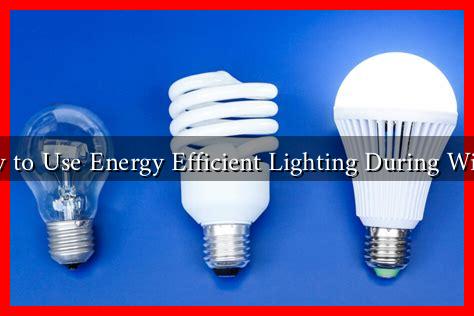-
Table of Contents
How to Use Energy Efficient Lighting During Winter
As winter approaches, the days grow shorter, and the need for effective lighting becomes more pronounced. However, with the rising costs of energy, it’s essential to consider how to illuminate our homes and workplaces without breaking the bank. Energy-efficient lighting not only reduces electricity bills but also contributes to a more sustainable environment. In this article, we will explore various strategies for using energy-efficient lighting during the winter months.
Understanding Energy-Efficient Lighting Options
Before diving into practical applications, it’s crucial to understand the types of energy-efficient lighting available. The most common options include:
- LED Bulbs: Light Emitting Diodes (LEDs) are highly efficient, using up to 80% less energy than traditional incandescent bulbs. They also have a longer lifespan, lasting up to 25,000 hours.
- CFLs: Compact Fluorescent Lamps (CFLs) use about 75% less energy than incandescent bulbs and can last up to 10,000 hours. However, they contain a small amount of mercury, which requires careful disposal.
- Smart Lighting: Smart bulbs can be controlled via smartphone apps, allowing users to schedule lighting and adjust brightness remotely, further enhancing energy savings.
Maximizing Natural Light
During winter, maximizing natural light can significantly reduce the need for artificial lighting. Here are some tips to make the most of daylight:
- Keep Windows Clean: Dirty windows can block sunlight. Regularly cleaning them can help maximize the amount of natural light entering your home.
- Use Light-Colored Curtains: Opt for sheer or light-colored curtains that allow sunlight to filter through while maintaining privacy.
- Strategic Furniture Placement: Arrange furniture to avoid blocking windows, ensuring that light can flow freely into your space.
Implementing Smart Lighting Solutions
Smart lighting systems can significantly enhance energy efficiency during winter. Here’s how:
- Automated Timers: Use timers to turn lights on and off according to your schedule, ensuring that lights are only on when needed.
- Motion Sensors: Install motion sensors in less frequently used areas, such as hallways or bathrooms, to ensure lights are only activated when someone is present.
- Dimmer Switches: Dimming lights can reduce energy consumption and create a cozy atmosphere during the long winter evenings.
Case Studies: Real-World Applications
Several organizations and households have successfully implemented energy-efficient lighting strategies during winter. For instance, a study conducted by the U.S. Department of Energy found that households that switched to LED lighting reduced their energy consumption by an average of 50% during the winter months. Additionally, a community center in Minnesota installed smart lighting systems, resulting in a 30% reduction in their overall energy costs.
Statistics on Energy Savings
According to the Energy Information Administration (EIA), lighting accounts for approximately 15% of residential electricity use. By switching to energy-efficient lighting, households can save an average of $100 per year on their electricity bills. Furthermore, the Environmental Protection Agency (EPA) estimates that if every American home replaced just one incandescent bulb with an ENERGY STAR® certified LED bulb, it would prevent the greenhouse gases equivalent to the emissions from over 1 million cars.
Conclusion: Embrace Energy Efficiency This Winter
As winter sets in, the importance of energy-efficient lighting cannot be overstated. By understanding the various lighting options available, maximizing natural light, and implementing smart lighting solutions, individuals and organizations can significantly reduce their energy consumption and costs. The transition to energy-efficient lighting not only benefits your wallet but also contributes to a more sustainable future. Embrace these strategies this winter and enjoy a well-lit, energy-efficient home.
For more information on energy-efficient lighting options, visit the U.S. Department of Energy’s Energy Saver website.

